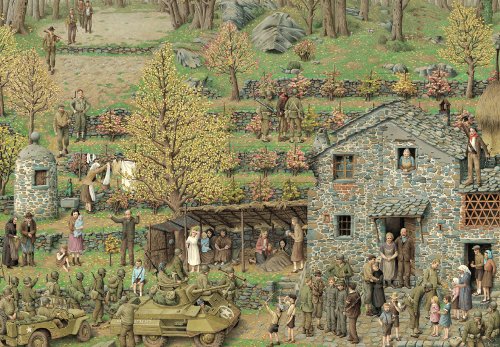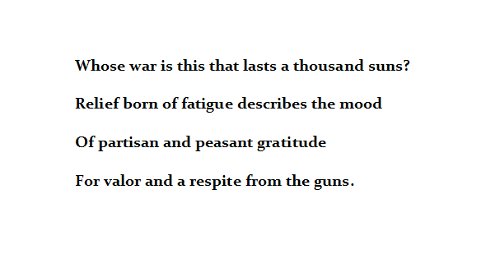Poetry Thursday-Slash-Friday:
If These Walls Could Speak . . .
 January 7th, 2010 by jules
January 7th, 2010 by jules
{Note: You can click on that spread to enlarge and see it in more detail; you’ll just have to wait a bit for the download.}
On this Poetry Friday I highlight a book published by Creative Editions (hubba whoa, they make some beautiful books) in August of ’09, written by J. Patrick Lewis and illustrated by Italian illustrator Roberto Innocenti. It’s an over-sized, lovingly-designed book (as many of Creative Edition’s books are), called The House, which chronicles—via quatrains—the life of a stone-and-mortar house, the “House of twenty thousand tales,” constructed in 1656.
 The house’s story begins when a family, living in 1900, find the house in the woods and decide to inhabit it after fixing it up a bit. Lewis and Innocenti then move us forward in time: First, a 1915 wedding (“Life holds its breath when weddings intervene”); the bride’s first child in 1916 (the illustration opposite this quatrain, incidentally, depicts a mother breastfeeding, which one rarely sees in picture books: Kudos to Innocenti for this); the death of the woman’s husband in 1918 (“From wife to widow … and the depths of grief”); and so on. Each poem has an illustration facing on the opposite page, along with the time period, and is then followed by a gorgeous, wordless, very detailed, and near-to-bursting spread that takes up every inch of air on the pages and is rendered in a very painterly, realistic style. (Booklist once described Innocenti’s illustrations as “hyperrealistic.”) It’s almost breathtaking this book is.
The house’s story begins when a family, living in 1900, find the house in the woods and decide to inhabit it after fixing it up a bit. Lewis and Innocenti then move us forward in time: First, a 1915 wedding (“Life holds its breath when weddings intervene”); the bride’s first child in 1916 (the illustration opposite this quatrain, incidentally, depicts a mother breastfeeding, which one rarely sees in picture books: Kudos to Innocenti for this); the death of the woman’s husband in 1918 (“From wife to widow … and the depths of grief”); and so on. Each poem has an illustration facing on the opposite page, along with the time period, and is then followed by a gorgeous, wordless, very detailed, and near-to-bursting spread that takes up every inch of air on the pages and is rendered in a very painterly, realistic style. (Booklist once described Innocenti’s illustrations as “hyperrealistic.”) It’s almost breathtaking this book is.
The house sees, as already mentioned, matrimony, birth, and death — but also war, “{c}atastrophe, despair and hatred,” some solitude and neglect (“Mold is my master after twenty years / And I am captive to this solitude”), military occupation, a hippie or two, and—in its final stage just before the dawn of the new millennium—a little bit of excess. A modern family renovates the home, adding a pool and a guard dog. “What became of the maxim, More is less?” Lewis writes. “Yet always I shall feel the sun and rain, / True keepers of the deed to my domain.”
Lewis writes with compassion from the house’s point-of-view. Writes School Library Journal, the “formal tone, sophisticated vocabulary, and preoccupation with life’s inevitable losses register the sensibility of an older and somewhat melancholy speaker: ‘From wife to widow…and the depths of grief./My furnace burns as children leave for school,/Bundled in virtue, books, and classroom fuel./How beautiful their innocence, how brief,'” and Kelly Fineman writes in her detailed review, “Lewis’s quatrains are evocative and in many ways complex, despite the ‘simplicity’ of the form.” Indeed. Gracing the 1958 spread: “The widow pours her milk and with a spoon / Stirs melancholy past the afternoon. / What bags her son has packed to move away / Contain all vestiges of yesterday.”
If you look at the cover and think, hey, they got the billing all wrong, no worries. You’ll see here, as the poet himself explains, the illustrations came first. I’ll let the esteemed Mr. Lewis do the talking, with thanks to him for stopping by:
The chance to work with Roberto Innocenti—and now for the second time—was a bit of Irish-Italian luck that fell to me, for which I am unable to express sufficient gratitude. It all began when Tom Peterson, the publisher of exquisitely beautiful books called Creative Editions, asked me to write the text to Roberto’s art for a book that became The Last Resort (Creative Editions, 2002), the story of an artist who loses his imagination and sets out on a quest to find it. The barely-disguised Roberto ends up at a seaside hotel whose residents are characters from literature—Huck Finn, the Little Mermaid, Long John Silver, and the like. And it’s here that he rediscovers himself.
When Tom then asked me to consider the art for The House (2009), I was tickled and astonished in equal measure. The concept of the same house appearing in double-page spreads fifteen times over the course of the 20th century—through war, famine, depression and modernity—was breathtakingly original.
Roberto and I did not “collaborate” in the sense of working cheek by jowl to finish the project. We have never met, never spoken. Again, his art came first, then my words. I can’t count how many revisions my book-length poem—one quatrain per page—went through before we thought we had it just right. But in the end, I freely confess, the art wins the day, as it does in all of Roberto’s books. It’s simply a privilege to hitch my wagon to the Hans-Christian-Andersen-Award-winner’s star.
A sumptuous book. Thanks to Pat for stopping by and to the publisher for the art. Oh, that reminds me:
THE HOUSE. Copyright © 2009 by J. Patrick Lewis. Illustrations © 2009 by Roberto Innocenti. Reproduced by permission of the publisher, Creative Editions, Mankato, MN.
The Poetry Friday round-up can be found today at the one and only Miss Rumphius Effect. Enjoy.



It is a truly gorgeous book and fabulous concept, thought despite his modesty, I think it’s clear that Pat’s writing doesn’t pale in comparison to the art.
Thanks for featuring this – one of my favorite books to hold, read, and admire from last year.
That upside down way of creating a book (I did one that way once with Ruth Sanderson and a number of times with the photographs of my son Jason Stemple) can stretch a writer in many interesting, creative ways. Pat Lewis is as much of a gem as Innocenti. The book is astonishing.
Jane
Gorgeous art. Can’t wait to hold this one in my hands.
I agree about Pat’s writing. I asked him if he wanted to write further about the writing of the poetry, and he simply wants to let the art and words speak for themselves. Which is also wise.
Such a beautiful book all over and inside and out.
Thanks for the additional insight (from Mr. JPL) on the “collaboration”. Never met!!!!! Whoa.
I saw the original art for this book last December in Paris at the Salon du Livre in Montreuil. I initially had no clue what the “story” was but I soon found myself being engrossed in comparing the “stories” in each painting. They build and grow, layer on layer of events and evidence and then there’s a resolution that is so eloquent but also so quiet that it shouts.
It’s stunning, isn’t it? So glad you liked it and featured it!
This makes me wish I knew what it felt like to live in a house for years and years and years…
Wonderful! You know, you should start a children’s book of the month club and send out these beauties. Membership to your BOMC would make a great present. I know, too complicated. But a person can dream…
I saw as well the art in Montreuil and it is true that every painting might stand alone telling a story, typical of Innocenti I shall say… The writing is amazing as well as the art. If you think that it took ages for Innocenti to be appreciated in his own country, as always here in Italy I have to admit with much shame and sorrow… the same happened to Leo Lionni and his art. I don’t know why we always wait for someone to become popular abroad and then we start appreciating, as if risking were too much! Well, apart from this outburst, thanks Jules for bringing this masterpiece to further light!
Cristiana
Oh, my goodness. Must have this. This is sooo lovely and, knowing the writing of Mr. JPatrick, I’m quite sure it lives up to the art!
The whole concept reminds me of my wedding – in the yard at my grandmother’s house. We had a string quartet play a little Bach for a moment of reflection but they played for waaaaay more than a moment. Later, my grandmother told me that during it, she traced the history of the house in her head: other weddings and celebrations, babies born, sorrows weathered. Then to the previous owners. And so on. “When I got to prehistoric times,” said Mame, “I knew those string players had gone too far!”
lovely bit of a reminder that war is not new; sad and apt
Oh, that sounds lovely.
I love images and stories that are so richly detailed.
[…] do. Lately here at 7-Imp, I’ve shone the spotlight on some international author/illustrators (Roberto Innocenti, Dorothée de Monfreid, Sebastian Meschenmoser), which I always enjoy doing for many reasons, and […]
[…] several review copies last year from Creative Editions, but I’m glad I did. One of them was this beautiful book, featured a couple weeks ago. The book featured today, Moon Theater (August 2009), […]
[…] 7-Imp: Can you talk about the genesis of two of your recent titles (not your most recent, to be clear), Skywriting: Poems to Fly and The House? […]
[…] oils bandwagon with my current influences — Michael Sowa, Quint Buchholz, Tony Meeuwissen, Roberto Innocenti, and the ludicrously brilliant Shaun Tan (who I wrote my MA thesis on and cited heavily in a […]